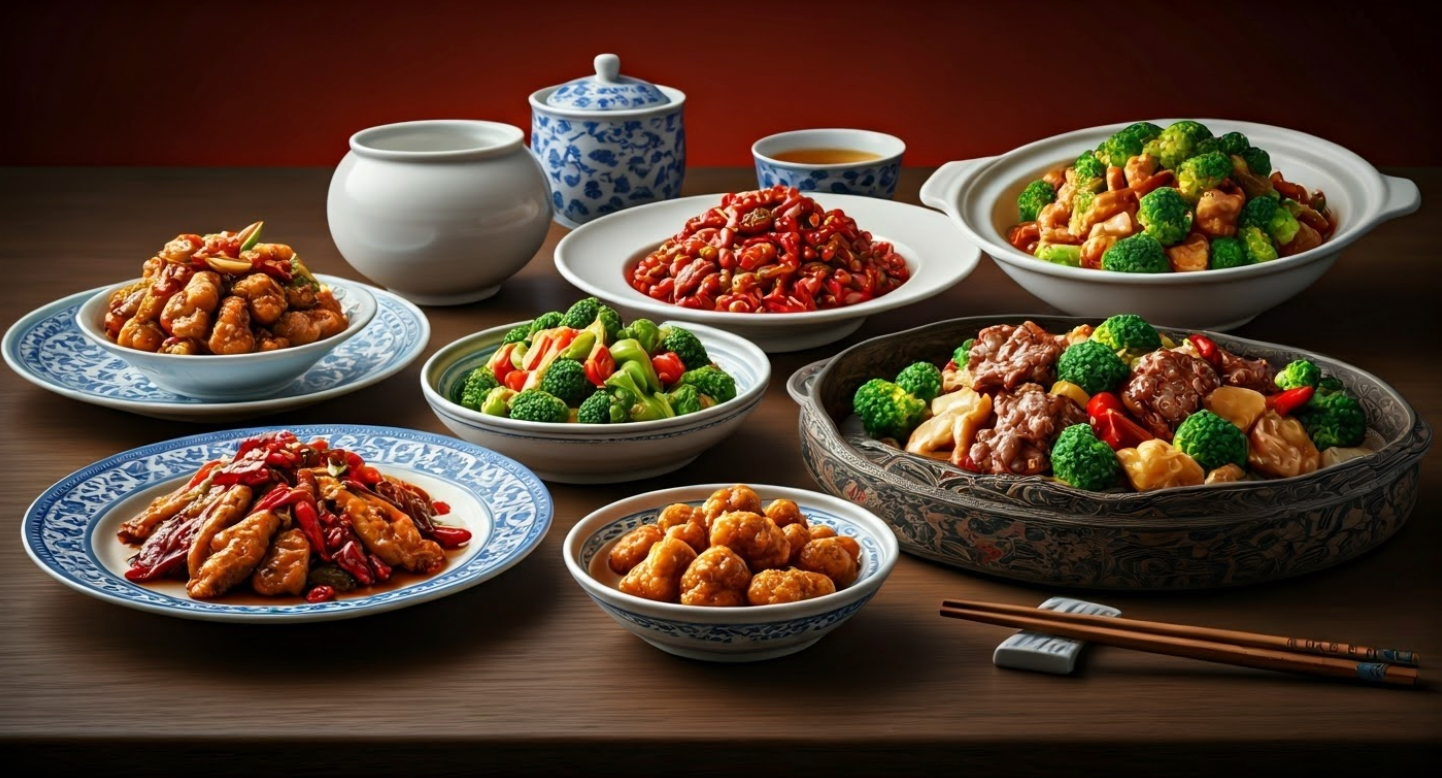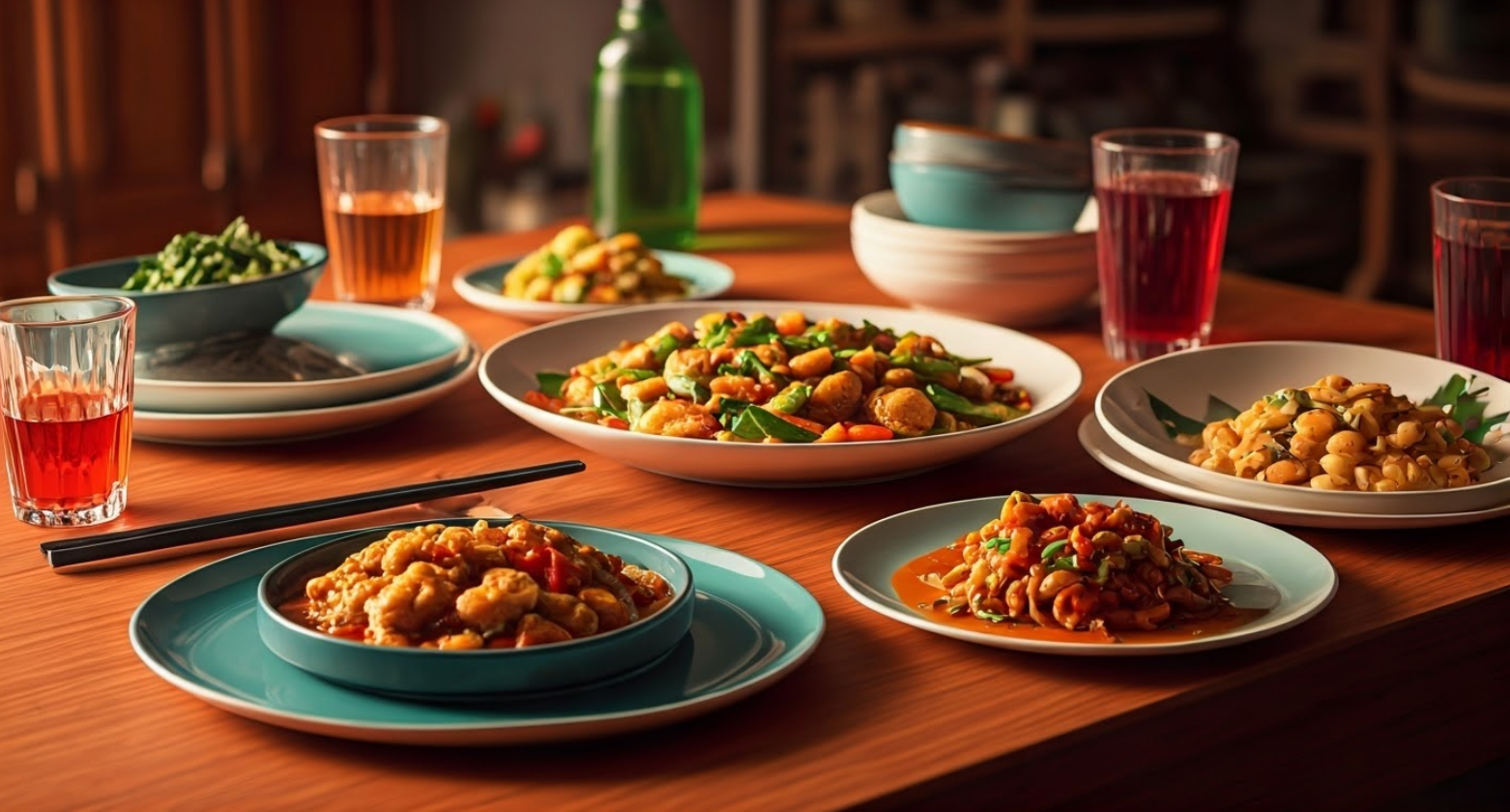Understanding Chinese Cuisine
Chinese cuisine is a vast and intricate tapestry of flavors, techniques, and traditions that have evolved over millennia. Its complexity stems from a rich history, diverse regional influences, and a profound cultural emphasis on food as more than mere sustenance. Let’s Dive into into the fascinating world of Chinese culinary arts.
A Brief History of Chinese Culinary Traditions
Chinese cuisine’s story begins in ancient times. Archaeological evidence shows it had advanced cooking methods thousands of years ago. Early Chinese civilizations cultivated rice and millet, laying the groundwork for a cuisine that would become renowned worldwide. As dynasties rose and fell, each left its mark on the culinary landscape.
During the Han Dynasty, innovative food preservation techniques emerged, allowing for greater variety in diets across seasons. The Tang Dynasty saw an explosion of flavors as the Silk Road brought exotic spices to Chinese kitchens. Culinary artistry reached new heights in the Song Dynasty, with chefs focusing on presentation as much as taste.
- Han Dynasty: Introduction of shaobing bread
- Tang Dynasty: Influx of spices like cinnamon and cloves
- Song Dynasty: Emphasis on food presentation
- Ming Dynasty: Refinement of culinary aesthetics
Regional Variations in Chinese Cooking Styles
China’s vast territory has many climates and ingredients. Its diverse cultures also influence its food. This has created distinct regional cuisines. Each area has developed unique flavors, cooking methods, and signature dishes.
Northern Chinese cuisine, centered around Beijing, favors wheat-based staples and hearty flavors. The south, especially Guangdong province, is known for its Cantonese cuisine. It prioritizes fresh ingredients and subtle seasonings. Eastern China’s cuisine is characterized by its use of seafood and sweet-and-sour flavors.
- Northern China: Wheat-based dishes, salty flavors
- Southern China: Fresh ingredients, subtle tastes
- Eastern China: Seafood, sweet and light flavors
- Western China: Halal influences, hearty meals
- Central China: Spicy dishes, bold flavors
Popular Ingredients and Flavors in Chinese Dishes
The Chinese pantry is diverse and sophisticated, with various ingredients used to create complex flavor profiles. Soy sauce, a fermented product of soybeans, is ubiquitous in Chinese cooking, providing depth and umami. Garlic and ginger form the aromatic base of many dishes, while chili peppers add heat to regional cuisines like Sichuan and Hunan.
Rice and noodles are staple foods prepared in countless ways across different regions. Chow mein noodles are a fundamental component of Chinese cuisine, highlighting their versatility in various chow mein dishes. The use of herbs and spices varies widely, with five-spice powder being a common blend that encapsulates the balance of flavors sought in Chinese cooking.
- Staple foods: Rice, noodles, wheat products
- Key seasonings: Soy sauce, vinegar, sesame oil
- Aromatics: Garlic, ginger, scallions
- Spices: Five-spice powder, Sichuan peppercorns
- Proteins: Pork, chicken, fish, tofu, ground pork (used in flavorful zhajiang sauce)
The philosophy of yin and yang permeates Chinese cuisine, emphasizing balance not just in flavors but also in textures, temperatures, and nutritional value. This holistic approach to food reflects a broader cultural understanding of health and well-being.
Navigating a Chinese Restaurant Menu
Understanding a Chinese restaurant menu opens up a world of culinary delights. Menus often feature an array of dishes, some familiar and others intriguingly new. Let’s break down the typical structure and content you might encounter. To effectively read a Chinese menu, it’s important to understand menu prices and identify basic food characters to navigate the dining experience confidently.
Common Sections Found in Chinese Menus
Chinese restaurant menus typically organize dishes into distinct categories, each offering a different aspect of the meal:
- Appetizers (前菜 – Qián cài) – Common options include egg rolls, chicken teriyaki, and mixed platters featuring chicken wings.
- Soups (汤 – Tāng)
- Main Courses
- Chicken Dishes (鸡肉菜 – Jī ròu cài)
- Beef Dishes (牛肉菜 – Niú ròu cài)
- Pork Dishes (猪肉菜 – Zhū ròu cài)
- Seafood Dishes (海鲜菜 – Hǎixiān cài)
- Vegetable Dishes (蔬菜菜 – Shūcài cài)
- Rice and Noodles (饭和面 – Fàn hé miàn)
- Chef’s Specialties (厨师特色 – Chúshī tèsè)
- Desserts (甜点 – Tián diǎn)
- Beverages (饮料 – Yǐnliào)
Explanation of Dish Categories
Appetizers serve as tantalizing preludes to the main meal. These small plates often include items like spring rolls, dumplings, or cold salads. They’re designed to awaken the palate and stimulate appetite.
Soups in Chinese cuisine range from light, clear broths to rich, hearty concoctions. Some popular options include hot and sour soup, wonton soup, and egg drop soup. These can be enjoyed as starters or alongside the main course.
Main courses form the heart of Chinese dining. These dishes typically feature a protein source combined with vegetables and sauces. They’re often served family-style, encouraging sharing and sampling of multiple flavors.
- Chicken dishes might include classics like Kung Pao Chicken or Lemon Chicken
- Beef offerings could feature Beef with Broccoli or Mongolian Beef
- Pork dishes might showcase Sweet and Sour Pork or Twice-Cooked Pork
- Seafood options often include Steamed Fish or Shrimp with Lobster Sauce
- Vegetable dishes cater to vegetarians and add balance to meat-heavy meals
Rice and noodle dishes can serve as simple accompaniments or as meals in their own right. Fried rice, lo mein, and chow mein are popular choices in this category.
Chef’s specialties often highlight unique creations or showcase premium ingredients. These dishes may reflect regional specialties or the chef’s flair.
Tips for Deciphering Unfamiliar Menu Items
Navigating an unfamiliar menu can be daunting, but a few strategies can help:
- Look for key ingredients in dish names
- Ask about cooking methods to understand textures and flavors
- Learn common Chinese culinary terms
- Don’t hesitate to ask servers for explanations or recommendations
- Pay attention to spice level indicators
- Consider regional specialties if the restaurant focuses on a particular cuisine
- Utilize translation apps for menus with Chinese text
Exploring new dishes is part of the adventure of dining out. Each unfamiliar item represents an opportunity to discover a new favorite. Remember, Chinese cuisine is vast and varied, offering something for every palate.
- Spring rolls and dumplings are common appetizers
- Soups can range from light to meal-like
- Main courses often feature a protein with vegetables
- Rice and noodles can be sides or main dishes
- Chef’s specialties showcase unique creations
- Desserts might include items like almond cookies or sweet soups
- Tea is a traditional beverage choice
By understanding menu structure and being open to new experiences, you can fully appreciate the rich tapestry of flavors Chinese cuisine has to offer.

Must-Try Appetizers and Soups
Chinese cuisine offers an enticing array of appetizers and soups that set the stage for a memorable dining experience. These dishes showcase the diverse flavors and textures that have made Chinese food beloved worldwide.
Popular Chinese Starters
The world of Chinese appetizers is rich and varied, offering something for every palate:
- Spring Rolls: Crispy, golden-brown rolls filled with vegetables or meat
- Dumplings: Versatile pockets of flavor, from steamed jiaozi to pan-fried potstickers
- Egg Rolls: Larger than spring rolls, typically containing a mixture of meat and vegetables
These starters provide a delightful introduction to the meal, combining different textures and tastes. Spring rolls offer a satisfying crunch, while dumplings showcase the delicate balance of flavors within their thin wrappers.
Traditional Chinese Soups
Chinese soups range from light and refreshing to rich and complex:
- Hot and Sour Soup: A Sichuan classic balancing spicy and tangy flavors
- Wonton Soup: Delicate dumplings in a clear, flavorful broth
- Egg Drop Soup: A comforting soup with silky egg “flowers” in chicken broth
These soups not only warm the palate but also demonstrate the skill of Chinese chefs in creating depth of flavor. Hot and sour soup, with its bold taste profile, contrasts beautifully with the subtle elegance of a well-made wonton soup.
Vegetarian Appetizer Options
For those seeking plant-based options, Chinese cuisine offers several delicious choices:
- Vegetable Dumplings: Filled with finely chopped vegetables
- Cucumber Salad: Refreshing slices in a tangy vinegar dressing
- Edamame: Steamed soybeans, a healthy and satisfying starter
These options showcase the versatility of Chinese cooking techniques applied to vegetarian ingredients. The cucumber salad, for instance, demonstrates how simple ingredients can be transformed into a flavorful dish through careful seasoning.
Signature Main Courses
Chinese main courses are evidence of the cuisine’s diversity, featuring a wide range of ingredients and cooking methods.
Iconic Chicken Dishes
Chicken dishes often take center stage in Chinese restaurants:
- Kung Pao Chicken: A spicy Sichuan dish with diced chicken, peanuts, and vegetables
- General Tso’s Chicken: Sweet and spicy crispy chicken, popular in American Chinese cuisine
These dishes exemplify the bold flavors and textures found in Chinese cooking. Kung Pao Chicken, with its combination of tender meat, crunchy peanuts, and spicy sauce, offers a multi-dimensional taste experience.
Beef and Pork Specialties
Beef and pork dishes showcase different regional styles and cooking techniques:
- Beef and Broccoli: Tender beef slices stir-fried with crisp broccoli
- Sweet and Sour Pork: Crispy pork in a vibrant sauce with vegetables and pineapple
- Double Cooked Pork: A popular Sichuan dish known as twice-cooked pork, where the pork is first boiled and then cooked with various ingredients. This dish has historical origins attributed to a Chinese poet from the Song Dynasty, emphasizing its cultural significance and popularity.
These dishes demonstrate the Chinese culinary principle of balancing flavors and textures. The savory depth of beef and broccoli contrasts nicely with the bright, tangy notes of sweet and sour pork.
Seafood Delicacies
Seafood plays a significant role in Chinese cuisine, especially in coastal regions:
- Steamed Fish with Ginger: A light, healthy dish showcasing fresh fish
- Shrimp with Lobster Sauce: Tender shrimp in a rich, egg-based sauce
These dishes often highlight the natural flavors of the seafood, enhanced by complementary ingredients. The delicate taste of steamed fish pairs beautifully with the sharp notes of ginger and scallion.
Vegetarian and Tofu-Based Entrees
Chinese cuisine offers numerous options for vegetarians and tofu lovers:
- Mapo Tofu: A spicy Sichuan dish featuring soft tofu cubes
- Buddha’s Delight: A medley of vegetables and tofu in a light sauce
These dishes showcase the versatility of tofu and vegetables in Chinese cooking. Mapo Tofu, with its bold, spicy flavor, proves that vegetarian dishes can be just as satisfying as meat-based options.
Noodle and Rice Dishes
Noodles and rice form the foundation of many Chinese meals, offering a variety of textures and flavors.
Various Types of Chinese Noodles
Chinese cuisine features an impressive array of noodle dishes:
- Lo Mein: Soft wheat noodles tossed with vegetables and protein
- Chow Mein: Crispy pan-fried noodles topped with stir-fried ingredients
- Dan Dan Noodles: A spicy Sichuan specialty with thin noodles in chili oil
Each noodle dish offers a unique texture and flavor profile. The chewy bite of lo mein contrasts with the crispy texture of chow mein, while dan dan noodles deliver a spicy kick.
Popular Fried Rice Variations and Recipes
Fried rice dishes showcase the Chinese talent for transforming simple ingredients:
- Yangzhou Fried Rice: A colorful mix of eggs, shrimp, pork, and vegetables
- Seafood Fried Rice: A deluxe version featuring an assortment of seafood
These dishes demonstrate how leftover rice can be elevated into a delicious meal. The variety of ingredients in Yangzhou fried rice creates a satisfying dish with multiple flavors and textures in each bite.
Regional Noodle Specialties
Different regions of China have their unique noodle dishes:
- Lanzhou Beef Noodle Soup: Hand-pulled noodles in a rich beef broth
- Zhajiangmian: Thick wheat noodles topped with a savory pork sauce made with ground pork
These regional specialties offer insight into local tastes and ingredients. Lanzhou beef noodle soup, with its complex broth and chewy noodles, is a meal, while zhajiangmian showcases the heartier flavors of northern Chinese cuisine with its flavorful ground pork sauce.
Sauces and Seasonings
Important Chinese Sauces
Chinese cuisine is renowned for its rich and diverse flavors derived from important sauces. These sauces are the backbone of many traditional Chinese dishes, adding depth and complexity to the flavors.
- Soy Sauce: This ubiquitous sauce is a cornerstone of Chinese cooking. Made from fermented soybeans, water, and salt, soy sauce adds a salty, savory, umami flavor to dishes. It’s used in everything from marinades and stir-fries to dipping sauces, making it an indispensable ingredient in any Chinese food menu.
- Hoisin Sauce: Known for its sweet and savory profile, it is made from soybeans, garlic, chili peppers, and various spices. It’s commonly used as a marinade, in stir-fries, or as a dipping sauce, particularly for dishes like Peking Duck and barbecued pork.
- Oyster Sauce: This flavorful sauce, made from oyster extract, sugar, and cornstarch, is a staple in many Chinese kitchens. It imparts a rich, savory taste to stir-fries, marinades, and dipping sauces, enhancing the natural flavors of the ingredients.
- Sweet and Sour Sauce: A favorite in many Chinese restaurants, sweet and sour sauce is made from sugar, vinegar, and often ketchup or tomato sauce. It’s typically used in deep-fried dishes like sweet and sour pork, providing a delightful balance of tangy and sweet flavors.
- Kung Pao Sauce: This spicy sauce, originating from Sichuan cuisine, is made from chili peppers, garlic, ginger, and soy sauce. It’s the key ingredient in Kung Pao Chicken, giving the dish its signature heat and depth of flavor.
Common Seasonings and Their Uses
In addition to sauces, Chinese cuisine relies on various seasonings to create distinctive flavors. These seasonings enhance the taste and aroma of dishes, making them truly unforgettable.
- Ginger: This aromatic root adds warmth and depth to many Chinese dishes. It’s commonly used in stir-fries, marinades, and soups, providing a subtle spicy kick that complements other flavors.
- Garlic: A staple in Chinese cooking, garlic is used to add a robust flavor and aroma to dishes. It’s often found in stir-fries, marinades, and sauces, enhancing the overall taste profile.
- Five-Spice Powder: This unique blend of cinnamon, cloves, fennel seeds, star anise, and Sichuan peppercorns creates a balanced flavor profile in marinades, stir-fries, and braises. It embodies the Chinese culinary philosophy of balancing different tastes.
- Sichuan Peppercorns: Known for their numbing and slightly spicy flavor, Sichuan peppercorns are a key ingredient in Sichuan cuisine. They taste distinctive dishes like Mapo Tofu and Kung Pao Chicken.
- Scallions: Also known as green onions, scallions add a fresh, mild onion flavor to dishes. They are often used as a garnish or added to stir-fries and sauces for an extra layer of flavor.
Regional Specialties and Desserts
Unique Dishes from Different Regions
China’s vast landscape and diverse cultures have given rise to various regional cuisines, each with unique flavors and specialties. Here are some must-try dishes from different regions:
- Sichuan Province: Famous for its bold and spicy cuisine, Sichuan Province offers dishes like Kung Pao Chicken, Mapo Tofu, and Twice-Cooked Pork. These dishes are known for their use of Sichuan peppercorns and chili peppers, creating a numbing and spicy sensation that is truly unique.
- Cantonese Province: Known for its delicate and subtle flavors, Cantonese cuisine includes dishes like Dim Sum, Roast Goose, and Congee. The emphasis is on fresh ingredients and light seasoning, allowing the natural flavors to shine through.
- Hunan Province: Hunan cuisine is characterized by its spicy and smoky flavors. Dishes like Smoked Pork, Steamed Fish, and Braised Pork Belly are staples, often featuring a generous use of chili peppers and garlic.
- Shandong Province: This region is known for its fresh and light cuisine, focusing on seafood and vegetables. Popular dishes include Steamed Seafood, Braised Abalone, and Stir-Fried Vegetables. They all showcase the ingredients’ natural flavors.
- Fujian Province: Fujian cuisine is light and delicate, often featuring seafood and soups. Dishes like Steamed Fish, Braised Pork Belly, and Stir-Fried Vegetables are common, with an emphasis on umami-rich ingredients like soy sauce and oyster sauce.

Frequently Asked Questions
What are the must-try dishes for a first-time diner at a Chinese restaurant?
For a great first-time experience, we suggest you try famous dishes like Peking Duck, Kung Pao Chicken, and Dim Sum. If you want to be adventurous, enjoy the shared experience of Hot Pot or taste the delicious Mongolian Beef.
How can I ensure I’m ordering authentic Chinese food?
- Search for restaurants that focus on regional Chinese cuisine.
- Ask about traditional dishes.
- Feel free to check if certain items are authentic.
- Look into “secret menus” for unique food options.
Are there vegetarian options in Chinese cuisine?
Chinese cuisine has many vegetarian choices. Tofu is a key ingredient. You can try dishes like Vegetable Spring Rolls, Mapo Tofu (ask for the vegetarian version), and lots of stir-fries focused on vegetables.
What are some tips for ordering Chinese food for a large group?
Try the Chinese way of sharing food by ordering “family style.” This means you pick different dishes from various parts of the menu templates. Make sure you choose large portions so everyone can enjoy them.
How has Chinese food adapted to American tastes?
Chinese-American food has changed some dishes, such as Sweet and Sour Pork and General Tso’s Chicken. These dishes are often sweeter and saucier to please American tastes. Mapo Tofu (ask for the vegetarian version) and lots of stir-fries focused on vegetables.
What are some tips for ordering Chinese food for a large group?
Try the Chinese way of sharing food by ordering “family style.” This means you pick different dishes from various parts of the menu templates. Make sure you choose large portions so everyone can enjoy them.
How has Chinese food adapted to American tastes?
Chinese-American food has changed some dishes, such as Sweet and Sour Pork and General Tso’s Chicken. These dishes are often sweeter and saucier to please American tastes.

